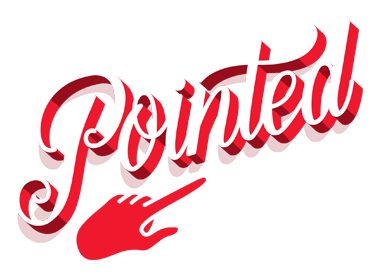In the summer of 2019, Google, IPSOS, and the Female Quotient—a women-owned business committed to furthering equality—partnered to survey over 2,500 US consumers of various backgrounds on diversity and inclusion in marketing.
They found that 64% of consumers are more likely to take action (including actually purchasing a product) after seeing an ad they consider to be diverse or inclusive.
In the wake of George Floyd’s murder and the worldwide protests that have followed, diversity and inclusion initiatives have finally transitioned from a boilerplate paragraph on a company’s website to a genuine business imperative.
But while many B2C brands have taken bold steps forward with their own inclusive strategies, it’s hard to find examples of B2B brands doing the same. As the B2B SaaS space increasingly embraces content marketing as a key growth strategy, thoughtful campaigns that leverage diversity and inclusion can win big with a previously untapped pool of new prospects—but only if they mean it.
In this article, we’ll explore why inclusive marketing matters for B2B and SaaS brands and how to avoid becoming the Pepsi of your niche.
Table of Contents
- What Is Diverse and Inclusive Marketing? (And Why it Matters for SaaS and B2Bs)
- 3 Steps to Creating Diverse and Inclusive Content Marketing Plans
- Get Serious—Inclusive Content Marketing Is Here to Stay!
What Is Diverse and Inclusive Marketing? (And Why it Matters for SaaS and B2Bs)
Instinctively, we all know diversity matters.
But until recently, we simply didn’t have the hard evidence to prove exactly how much it can matter to a company’s success or failure.
In fact, according to a 2015 study by McKinsey & Company, companies in the top quartile for racial, gender, or ethnic diversity are 15 to 35% more likely to post financial returns above their national industry medians. The study notes that diverse companies can improve their decision making and brand position with the customer, all of which leads to a virtuous cycle of increasing returns.
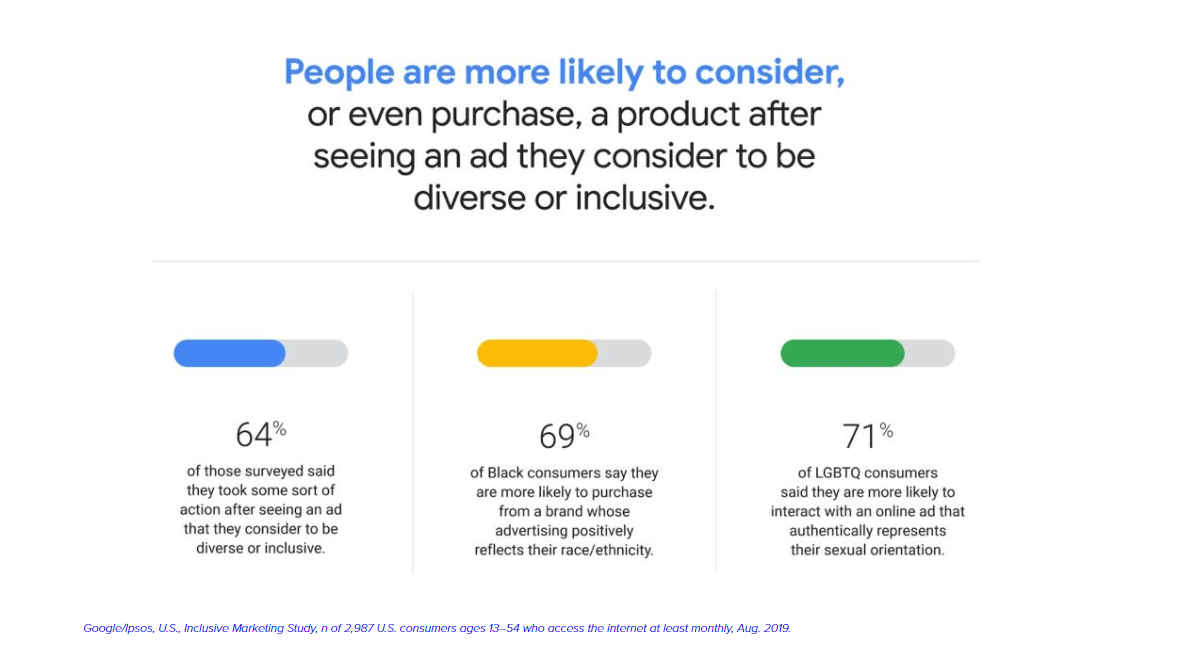
You can read more about the study on Inclusive Marketing and how the perception of authenticity plays a role in consumer behavior right here on The Female Quotient blog.
To be clear, inclusive content marketing doesn’t mean trying to please every prospect in a single campaign. Marketing campaigns that try to speak to everyone at once usually end up being colorless, and in extreme cases, outright offensive.
In addition, diversity and inclusion isn’t the same as diversifying your content marketing plan. Yes, adding a podcast to your lineup of ebooks and blog articles might enable you to reach a more diverse audience, but there’s an essential distinction to be made between these two concepts.
Diversifying your content marketing means spreading your budget across more tactics and formats—whitepapers, case studies, blog posts, expert collaborations etc. On the other hand, diverse and inclusive marketing means taking a more human, audience-focused approach across your content.
But different demographics have different needs and for many SaaS marketers, diversity and inclusion can seem like a Gordian knot. The good news is, when approached thoughtfully, you can make all types of B2B buyers feel represented in your content.
Here’s how.
3 Steps to Creating Diverse and Inclusive Content Marketing Plans
Google may have sponsored a study on Inclusive Marketing, but anyone with even a passing interest into how the tech giant treats its employees will quickly see that they don’t always get it right.
Diversity and inclusion aren’t buzzwords you throw around during board meetings or conferences.
In a world that seems to grow more diverse by the minute, diversity and inclusion is a multifaceted and ever-changing theme that requires constant iteration on many fronts.
“The marketing team has to stop thinking about diversity in a single layer,” says Kyle Golding, CEO of The Golding Group on the Neomarketing podcast, “It’s just not that simple. You cannot put a person of color or a same-sex couple in your marketing one time and call yourself champions of diversity. Embrace diversity of backgrounds, cultures, and subcultures along with thought processes and other natural ways people are different but yet similar at the same time. Do not perpetuate stereotypes or go for the obvious representations. Take all your preconceived notions off and simply be open to showing real people how they live and work,”.
So, how do B2B content marketing teams make diversity and inclusion a permanent part of their plans and processes?
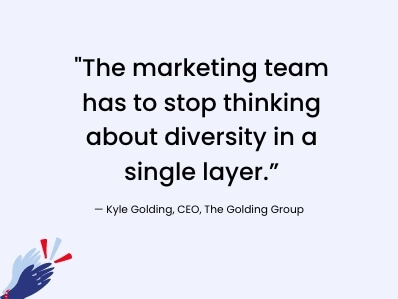
Step 1. Hire Better — Build diversity into the fabric of your content team
Preconceptions lead to stereotypes and knowledge gaps, no matter how impartial we think we are.
Working towards achieving diversity and inclusion without acknowledging or accounting for these biases only tends to worsen the situation.
Unfortunately, we can’t erase or switch off our hard-wired biases. But the effects can be diminished by deliberately building a diverse team, with each individual providing perspectives that allow for a richer and more comprehensive approach to content creation.
Here’s how we approached our hiring process to ensure inclusivity in our content team at Pointed. You could easily apply these same steps to your internal team, or even when outsourcing content to an agency.
First, we reviewed our brand positioning.
As mentioned earlier, it’s easy to start off a recruitment process oblivious of the true signals you are giving out. To mitigate this, we enlisted the help of Indianapolis based photographer and brand consultant Azia Ellis-Singleton to get an objective set of expert eyes on our brand. We reviewed our imagery, content and brand messaging for consistency and diversity. Most importantly, our content lead Maddy Bartlett and founder Brittany Ryan kept the whole team updated and ensured everyone had the chance to share their views on the new direction.
Proactively source diverse candidates:.
“Not getting enough applicants” is no longer an excuse. The fact is, hiring diverse talent requires a more intentional and action-oriented approach. When creating our job ads at Pointed, we state our diversity values clearly and use inclusive language and images. We also expand our candidate search beyond the usual talent watering holes—our career page, and LinkedIn—opting to search and reach out to candidates directly.
Choose the right tools for candidate screening.
Remember, in most instances, the medium is the message. We’re fans of AI, but wary about its role in hiring. Instead, we chose Breezy HR, a smart applicant tracking system that enabled us to automate the time-intensive parts of the hiring process like sorting, organizing and emailing applicants, so we can spend more time connecting with candidates and getting to know their unique backgrounds and worldviews. (Quick tip: video assessments are a great way to rapidly identify top contenders when hiring remotely.)
Lastly, we created an inclusive interview process:.
After all the hard work of sourcing and screening with diversity in mind, it would have been a disaster for talent to fall through the cracks because the interview process doesn’t recognize inclusivity. To minimize the bias, we used standardized (not off-the-cuff) questions for all candidates.
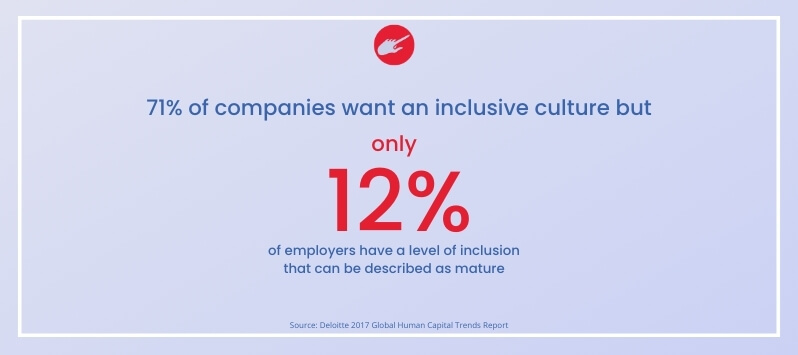
Step 2. Write conscious content — watch your pronouns, pop-culture references, and idioms
Words have a subtle yet potent influence on all of us.
When creating content, keep an all-encompassing view of your audience in mind. One tried and true norm of great copywriting is the use of the pronoun “you.” This allows you to speak directly to your audience and ensure they feel involved in the conversation.
But what about gendered third-person pronouns?
While defaulting to “he” might have been part and parcel of the traditional writing standards, this practice leaves readers who identify as female or non-binary out of the conversation. One simple way to account for this is to switch to the gender-neutral pronoun “they.” It can feel awkward at first, but it’s a great way to ensure you carry all members of your audience along with your content.
This is not to say that your content must resonate with everyone, every time. It’s just about knowing when to use one term over another. Encourage your content team to think about questions such as:
- When should we use gender-neutral pronouns?
- When should we use gendered pronouns?
- Are we using idioms or pop-cultural references that have negative connotations for particular audiences?
With a few simple questions in mind, you can easily create content that welcomes more readers (and customers) into your unique tribe.
Not sure where to start? The Conscious Style Guide is a one-stop resource on conscious language created by writer and editor Karen Yin. The website helps individuals create communication that is empowering, inclusive, mindful, kind, and respectful.
“Like fire, words have the power to warm or burn. And like fire, words can cause a great deal of damage regardless of intention,” says Karen Yin.
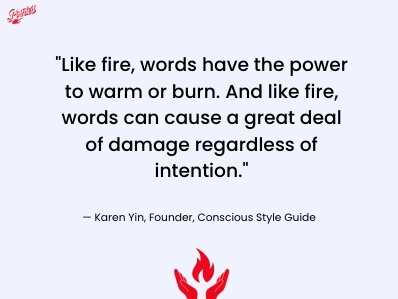
Step 3. Remember: representation matters — tell diverse stories through your imagery
Your audience should feel represented and included in the stories and content your team puts out—and visuals and videos are an easy way to make your audience feel welcome and part of the conversation.
To ensure that you are honest and intentional about celebrating diversity and inclusion in your videos and visual content, make sure to double-check both your externally facing imagery and your internal representation.
Ask yourself the following questions:
- Does your content accommodate those living with disabilities?
- Is your text readable?
- Are your images and videos inclusive?
- Are you unconsciously playing into racial stereotypes?
- Does any of your visual content or text portray a negative connotation or belief about a group of people?
Be clear about what you want your visual content to represent—from the headline to the hero image associated with it, make it easy for all your prospects to engage with your content.
Looking for diverse imagery? The Jopwell Collection (attribution required), Pexels, nappy.co and Lean in Collection by Getty Images are great go-to sources for diverse images and videos. These websites aim to upend visual labels in the daily life of work, home, and family in marketing imagery.
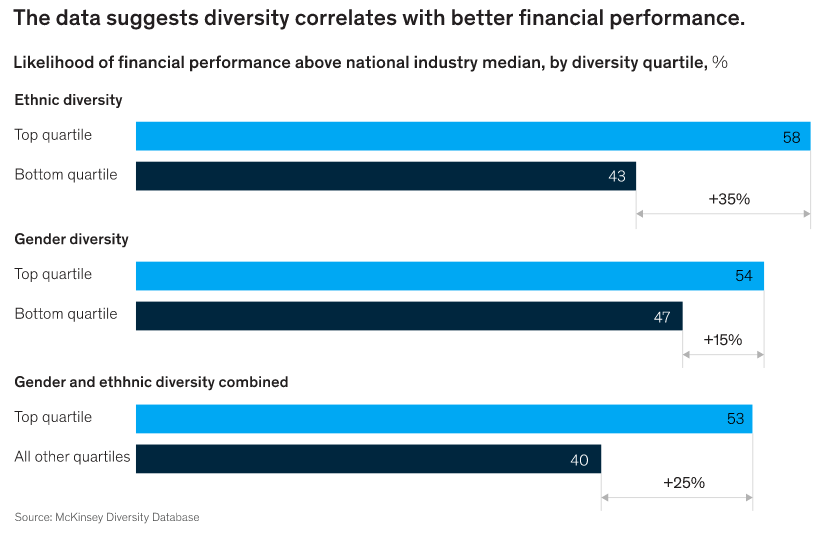
Get Serious—Inclusive Content Marketing Is Here to Stay!
It’s about time we accepted that inclusive marketing is no fluke. No doubt, creating diverse and inclusive content can be challenging. But as diversity and inclusion continues to grow and evolve based on the current political climate, SaaS and B2B brands will be tasked with doing more and better in their marketing efforts.
Besides, marginalized and underrepresented communities will speak with their wallet, as their buying power increases.
To move diversity forward, B2B content marketers must unlearn old habits and relearn new ones. Habits that go beyond awareness and focus on action and accountability for the content and conversations we share with our audience.
About Pointed
We’re a done-for-you content marketing agency that produces high-quality content that drives qualified traffic, leads and sales. If you’re ready to take your SaaS or business brand to the next level but aren’t sure where to start, we can help. Schedule a chat today!
Brittany is the Founder and Content Chief at Pointed Copywriting. She’s also an expat, entrepreneur, and ‘90s pop culture addict based in Nicosia, Cyprus. Brittany and the team at Pointed Copywriting are proud to serve quality copy and content strategy to groundbreaking SaaS, B2B and enterprise brands in over three countries and countless industry niches.
